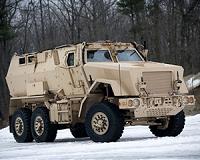 |
Tel Aviv, Israel (UPI) Sep 7, 2010 The long-term military cooperation agreement Israel has signed with Russia may be a key part of a deal under which Moscow, badly in need of foreign technology to reboot its moribund defense industry, will cancel or delay plans to sell Syria advanced systems. Israeli Defense Minister Ehud Barak and his Russian counterpart, Anatoly Serdyukov signed the deal in Moscow Monday. Neither side revealed details of the landmark agreement but Serdyukov said in a statement, "It's very important for us that in the transition to a new image, the Russian armed forces use the experience the Israeli armed forces have and the work they have done." The Israeli media reported before Barak flew to Moscow, the first Israeli defense minister to visit Russia, that high on his agenda was persuading the Russians to cancel plans to sell Syria supersonic P-800 Yakhont cruise missiles that would pose a serious threat to Israel's navy in the Mediterranean Sea. The Israelis fear these could be transferred to Hezbollah in Lebanon, which almost sank an Israeli corvette with an Iranian-supplied, Chinese-designed C-802 anti-ship missile soon after the 2006 war erupted. Israel is also uneasy about a Russian agreement in May to sell Damascus MiG-29 interceptor aircraft, Pantsir short-range air-defense missiles and armored vehicles. It has also been deeply concerned about a 2007 contract under which Moscow would sell Iran five batteries of advanced, long-range S-300PMU air-defense missiles systems. Moscow initially delayed delivery of the weapons under intense U.S. and Israeli diplomatic pressure, then announced it couldn't deliver the systems after the United Nations on June 9 imposed a fourth round of economic sanctions on Iran over its contentious nuclear program. Iran needs the powerful systems to boost protection of its nuclear infrastructure, which it fears Israeli will attack. Western intelligence sources say they suspect that Israel may have concluded that Moscow's commitments to Iran and Syria, the Islamic Republic's Arab ally, weren't considered solid enough to deter closer links with Russia. If that's the case, this could give the Israelis greater leverage over future Russian military sales to their adversaries in the Middle East. Serdyukov said Monday's agreement followed Russia's first military purchase from Israel, 12 unmanned aerial vehicles. Russia doesn't have the technology to build the sophisticated UAVs now used by the Americans, British and French in Afghanistan and Pakistan. Israel is a leading manufacturer of such high-tech craft. Serdyukov provided no details of the UAV deal but in April 2009 Moscow bought 12 UAVs built by state-run Israel Aerospace Industries, flagship of Israel's defense industry under a $53 million deal. The craft included IAI's second-tier craft, the Bird Eye 400 mini-UAV, the I-View MK 150 tactical drone and the medium-range Searcher Mark 2. It was Russia's first purchase of a foreign weapons system. Last June, the Israeli daily Haaretz reported that negotiations were under way between IAI and Moscow on setting up a $300 million-$400 million plant in Russia to build UAVs. But Israel, Haaretz said, was reluctant to provide Moscow with sensitive technology that could end up in the hands of Israel's enemies. The possibility of Moscow delivering the S-300 missiles to Iran was also undoubtedly a factor in Israel's decision at that time. But since Moscow has since formally announced it won't deliver the S-300s to Tehran, that obstacle would appear to have been removed. At the time, Russia was reportedly seeking to acquire 50 Israeli UAVs, particularly long-endurance craft. These included IAI's Heron, the largest Israeli surveillance drone with a 54-foot wingspan. It can stay aloft for 50 hours at an altitude of 30,000 feet. In June, the Western media quoted Ruslan Pukhov, director of the Center for Analysis of Strategies and Technologies, a Moscow research institute, as saying Moscow was ready to buy arms worth $12 billion from Europe and Israel, including IAI. Another indication of how the relationship between Israel and Russia seems to be warming came from Russian Prime Minister Vladimir Putin. He disclosed after Monday's agreement was signed that Moscow hopes to build a laser ranging ground station in Israel for the Global Navigation Satellite System, or Glonass, the Russian equivalent of the U.S.-designed Global Positioning System.
Share This Article With Planet Earth
Related Links The Military Industrial Complex at SpaceWar.com Learn about the Superpowers of the 21st Century at SpaceWar.com
 BAE Receives Contract To Upgrade Caiman MRAP
BAE Receives Contract To Upgrade Caiman MRAPHouston TX (SPX) Sep 07, 2010 BAE Systems has been awarded a $629 million contract from the U.S. Mine Resistant Ambush Protected (MRAP) Joint Program Office (JPO) to upgrade 1,700 Caiman MRAP vehicles. This award demonstrates how BAE Systems' Readiness and Sustainment capabilities are supporting the customer's current and future requirements by rapidly improving product performance to protect troops during combat missions. ... read more |
|
| The content herein, unless otherwise known to be public domain, are Copyright 1995-2010 - SpaceDaily. AFP and UPI Wire Stories are copyright Agence France-Presse and United Press International. ESA Portal Reports are copyright European Space Agency. All NASA sourced material is public domain. Additional copyrights may apply in whole or part to other bona fide parties. Advertising does not imply endorsement,agreement or approval of any opinions, statements or information provided by SpaceDaily on any Web page published or hosted by SpaceDaily. Privacy Statement |